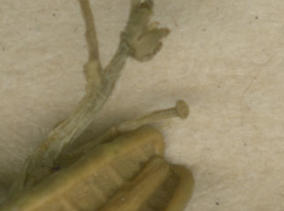You are here
Neotropical Euphorbiaceae s.l.
Leucocroton
SUMMARY
Trees or shrubs, dioecious. Exudate absent*. Unarmed*. Indumentum present, hairs stellate-lepidote. Stipules 0. Leaves distributed evenly along stem, alternate, simple, unlobed, often narrow, base symmetrical, margin entire or almost so, often rolled inwards beneath (revolute), leaf blade not pellucid–punctate; pinnate-veined (mostly) or with 3 or more veins from base?, sometimes venation obscure?; domatia absent*; stipel-like appendages absent*; leaf glands absent. Petiole present, without swellings or bends at base or apex*, without glands. Inflorescence with axis, axillary in the upper leaf–axils, male inflorescences short, spike- or panicle-like; bracts not leaf-like*, green. Male flowers: sepals 5; valvate, partially fused, greenish; petals 0; disc position?, annular; stamens 6–18, free, partially to completely fused?; anther without conspicuous modification, thecae introrse in bud; pistillode present or 0. Female flowers: pedicels present, not articulated*, sepals 5; partially fused, greenish; petals 0; disc surrounding the ovary, annular, thick, cushion-like, often lobed; ovary locules 3–4, ovules per locule 1; styles 3–4, very short, thick, partially fused, almost entire, shortly 2-lobed or fringed or 3-branched (i.e. ultimate divisions per locule 2–many), stigmas not flat*, surface papillose; staminodes absent. Fruit dehiscent, not sculptured*, densely hairy (always?), greenish to brown; seed without appendage, covering or membraneous layer*, not fleshy; embryo flat, not minute, cotyledons leaf-like.
An asterisk * indicates a state has been assumed but not yet confirmed.
Jestrow et al. (2010): 26 spp.
See: Jestrow, B. et al. (2010) Generic delimitation in the Antillean Adelieae (Euphorbiaceae) with description of the Hispaniolan endemic genus Garciadelia. Taxon 59(6): 1801–1814.
This description of Leucocroton is unsatisfactory, because it relies heavily on Radcliffe-Smith (2001)’s description, and that is based largely on his preceding one of Lasiocroton (“ very like .. Lasiocroton, differing chiefly in...[etc.] ). Some of the differences Radcliffe-Smith cited may need to be reassessed, following Jestrow (2010).




